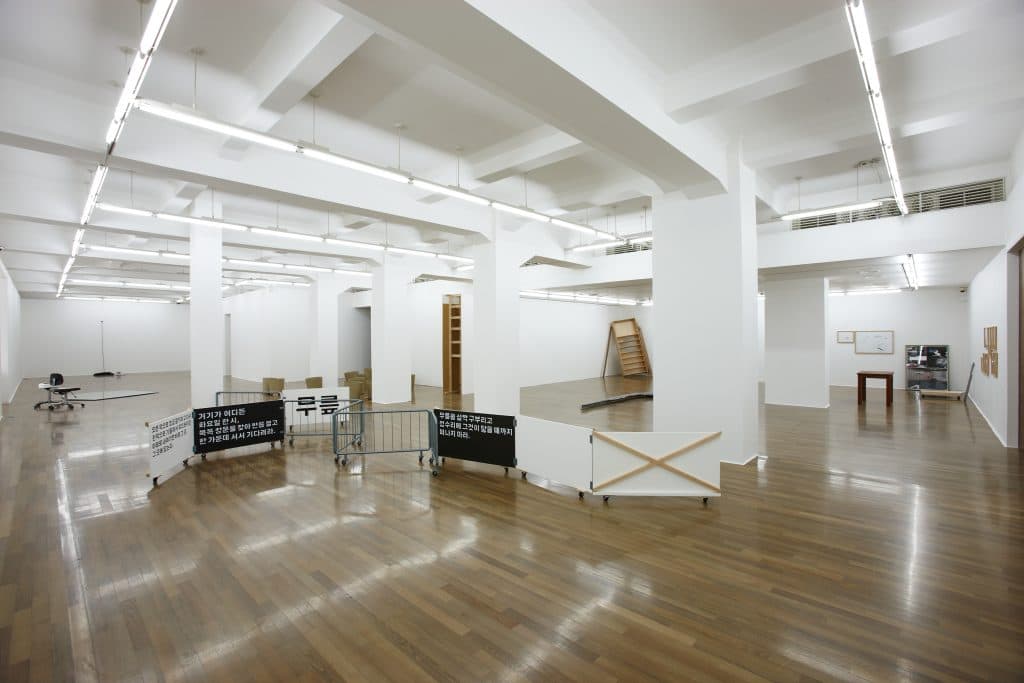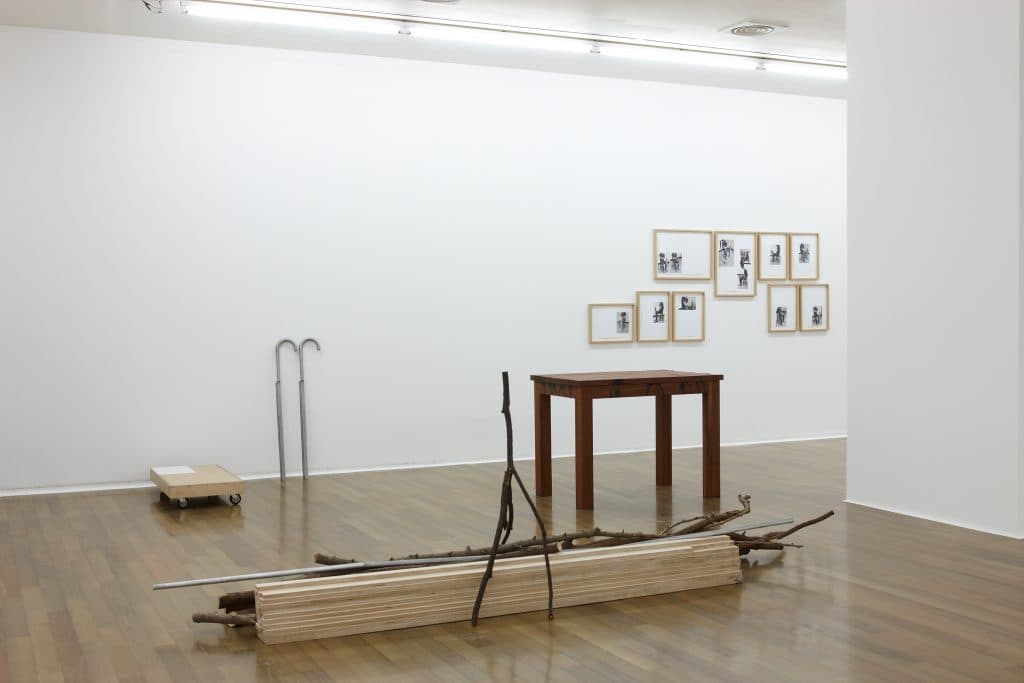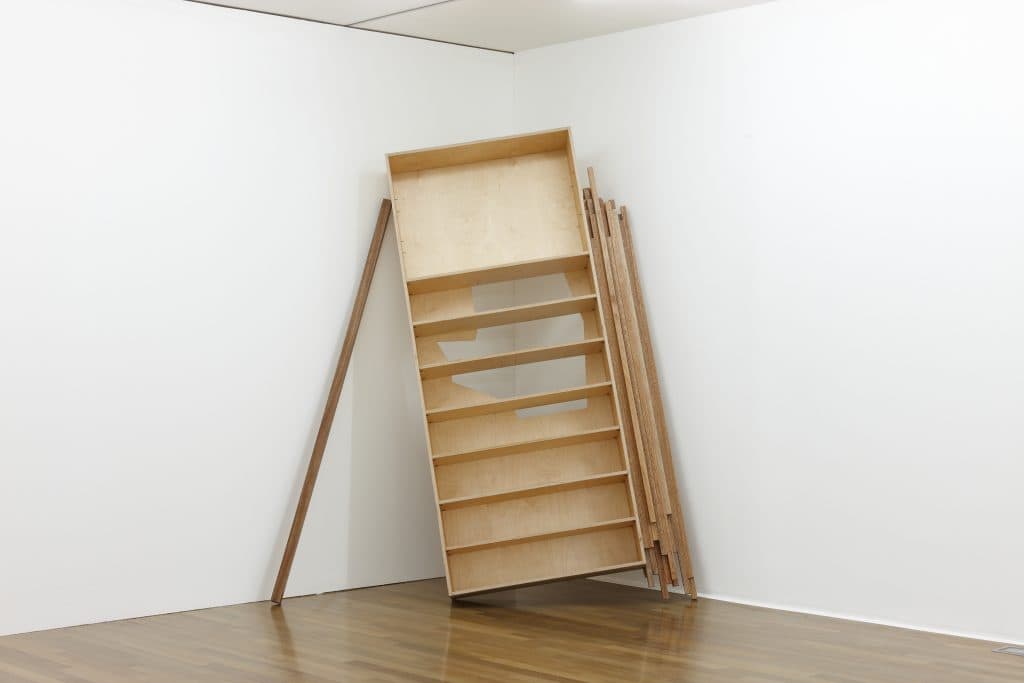그 동안 시각문화를 통한 인문, 문화적 담론을 만들어내는 것에 주력해 온 일민미술관은 동시대 미술 작가에 주목하는 개인전으로 작가 정서영의 «큰 것, 작은 것, 넓적한 것의 속도»전을 선보인다. 정서영은 1990년대 초중반부터 한국 미술계에서 본격적으로 “동시대 미술”의 시작이라고 볼 수 있는 미술적 변화의 증후를 보여줬던 작가로, 형식에 대한 근원적인 사유를 보여주는 작업을 조각, 설치, 드로잉, 퍼포먼스 등의 다양한 방식을 통해 지속해 왔다. 이번 전시의 제목은 올 1월 출간된 작가의 책 (『큰 것, 작은 것, 넓적한 것의 속도』, 정서영, 김현진 지음, 현실문화, 2013)과 동명이며, 이번 전시는 책에서 다루고자 했던 작가 정서영의 조각가로서의 사유와 그 면모에 집중하려는 의도로 기획되었다. 전시에서 작가는 ‘조각을 한다는 것이 무엇인가’라는 근원적이고 인식론적인 질문을 드러내는 작품을 통해 조각의 한계를 넘어서고자 노력하고 있으며, 이것은 전통적인 장르라 할 수 있는 조각을 통해 작가가 성취해 내는 하나의 미학적 장치라고 할 수 있다.
조각에 대한 인식론적 접근
지난 몇 년 간 작가는 조각에서 나아가 다양한 장르나 매체를 통해서도 ‘조각적 세계와 차원’을 탐색하고 구현하고 있다. 이번 전시에서 선보이는 15점의 작품들에는 신작 조각 작품 외에도 3 채널 퍼포먼스 비디오 영상 설치, 드로잉, 포토콜라주, 사운드 베이스 퍼포먼스 등 매우 다양한 방식의 작업이 포함되어 있는데, 이 작업들을 관통하는 것은 모두 조각적 차원과 영역에 대한 사유라고 할 수 있다. 이는 전시의 제목 «큰 것, 작은 것, 넓적한 것의 속도»에서도 찾아볼 수 있다. 이 문장은 얼마나 크고 작은지, 얼마나 넓적한 지, 속도는 실제로 어느 정도 빠르고 느린지, 어떤 물리적인 움직임인지 혹은 심상의 움직임인지 등을 전혀 정확히 가늠하기 어려워 상당히 모호하게 다가온다. 여기서 우리가 이해할 수 있는 것은 오직 어떤 크기나 모양을 가진 것의 물리적인 차원이 빠르거나 느리게 움직이는 상황이라는 것뿐이다. 이것을 작가의 작업 환경에서 생각해본다면, 어떤 크기의 물체가 만들어지는 속도 속에 놓여진 상황이라는 것은 다시 말해 바로 ‘조각’이 이루어지는 상황이자 순간이라고 이해할 수 있다. 즉, 이 제목은 바로 조각이 행해지는 내밀한 세계와 그 순간을 지시한다.
이번 전시는 크게 1,2층 공간으로 나뉘는데, 우선 1층 전시장에 설치된 세 채널의 비디오 작품 ‹미스터 김과 미스터 리의 모험›(2010-2012)은 어떤 포즈를 취하고 있는 다양한 인물들을 조각적으로 탐색한다. 본래 공연이었던 것을 기록하여 이번 전시에서 새로이 영상 설치 버전으로 제작된 이 작업은 당시 2시간 동안 하나의 자세나 동작을 고수하면서 조각이 되어야 했던 퍼포머들의 시간에 집중하며, 사람이 사물이 되는 고도로 집중되고 내밀한 시간을 포착해낸다. 작가는 연극이나 드라마 연기의 전형성이나 상투성이 몸에 밴 전문 배우를 고용하지 않고 평범한 주변 인문들이나 전문 배우가 아닌 일반인들을 초대하여 그들에게 염색한 긴 머리, 모나미 볼펜을 돌리는 소년의 손, 요괴 모양의 귀, 수염, 헝클어진 머리나 낡고 헐렁한 양말 등의 세부를 부여하고 그들의 정지된 모습 속에서 평범함과 비범한 사이에 있는 사물적 균열을 발견케 하고 있다.
2층은 조각 오브제, 설치, 퍼포먼스 비디오, 포토콜라주, 드로잉 등의 다양한 작업들이 공간 전반에 펼쳐져 있다. 전시장 입구의 오른쪽에서 먼저 만나게 되는 것은 무릎에 흙 탑을 놓고 자세를 취하는 사진들로 이루어진 사진 드로잉 시리즈이다. 이 작업은 일종의 이번 전시의 단초가 되는 작업이라고 할 수 있다. 사진 속 인물은 흙 탑이 무너지지 않도록 균형을 찾기 위해 여러 가지 자세를 취하게 되고 그것이 결국 이 사진에 담긴 몸의 조각적 자세가 되는 것이다. 이러한 방식은 기울어진 책장과 각목의 관계로 이루어진 조각인 ‹운동›(2013)과 사운드 퍼포먼스 작업인 ‹2013년 4시›(2013)에서도 살펴볼 수 있다. 즉, ‹운동›은 책상과 각목이 서로 기울어진 상태에서 기대어 균형을 찾을 수 있는 지점에서 그 조각적 형태가 결정된 것이며, ‹2013년 4시›의 퍼포머의 괴이한 몸의 자세는 바닥에 날카로운 소리를 더 잘 내기 위한 방편이자 그 추구의 결과로, 이 세 작업은 모두 조각적인 형태가 외적인 세계와의 균형과 긴장 관계에서 귀결되는 모든 과정과 관계적 시간의 결과임을 지시한다.
전통적인 형상 조각이 어떤 상상되는 이미지나 형상을 본뜨는 방식으로 삼차원적인 재현을 위해 제작된다고 볼 수 있다면, 정서영에게 있어서 조각적 사물의 외연은 결코 형상을 본뜨는 것이 아니라 관계들 간의 균형이나 긴장, 그리고 그 영역들을 탐색하는 작업적 순간의 내밀함이며 정서영의 작품들은 바로 그러한 영역을 보여준다. 조각을 한다는 것은 근본적으로 물리적 영역의 관계지음을 통해 일상의 바깥을 인식하고 통찰하는 문턱이 될 수 있도록 사물의 조건과 형성의 내적 시간을 숙고하는 것이다. 공간과 맺는 조각 오브제의 존립 방식 역시 사물의 언술에 지대한 영향을 미치기에, 정서영 작가의 작업과정은 사물이 매번 다른 전시 공간을 만나도 박물관적 오브제가 되는 것이 아니라 독립적인 조각의 삶을 사는 사물로서 어떻게 수행적인 사물이 될 것인가를 매우 집요하게 추구한다. 이러한 점 때문에 작가의 전시 공간은 결코 재생산 될 수 없는 어떤 안무적인 공간과 같기도 하다. 작가는 이번 전시에서 특히 2층 공간의 특성을 면밀하게 살펴 공간 중앙에 벽 속에 숨겨져 있던 창을 노출하거나 지난 전시의 가벽을 일부 잘라내어 작가 특유의 조각적인 제스처를 공간 내에 실현한다. 또한 천장의 구조와 조형성을 거울이 담아내도록 위치시켜서 건축의 조각적 양상을 포착해 내고 있다.
일반적으로 시간, 소리, 움직임을 이용하는 영상이나 퍼포먼스 영역이 가지는 동적이고 비물질적인 속성과는 달리 조각은 정적이고 물리적인 속성을 가지고 있다. 그러나 조각을 행하는 시간과 조각이 존재하는 시간, 그리고 작가가 그 조각영역의 사물성을 인식하는 세계는 정적이고 물리적인 것을 넘어선 하나의 사소한 요소와 세부들까지를 모두 구분하고 그들의 관계를 숙고하는 비결정적인 시간들의 연속이자 공간적인 세계-즉, 그리하여 정동의 흥미로운 긴장이 오고 가는 세계라고 할 수 있다. 이러한 조각적 차원을 작가는 바로 퍼포먼스, 사운드 설치, 그리고 텍스트 드로잉, 포토콜라주 등에서도 추구하고 있는 것이며, 이로서 자신을 좀 더 반성적으로 살피고 사물을 만드는 제작의 매너리즘에 구속되지 않도록 보다 근원적이면서도 자유로운 조각적 사고를 추구하면서 조각의 물질성으로부터 주어지는 한계를 조각 외부에서 극복해 낸다. 이처럼 장르나 매체의 구속 없이 조각적 세계를 사유하면서도 특유의 미학적 실현을 보여주는 정서영의 근작과 신작들은 오히려 정서영의 조각가적 확신을 드러낸다. 조각의 문제를 사고하는 작업들, 조각영역에 대한 질문으로 환원하는 작가의 메타적 사유, 그리고 그 내부에서 분투하는 작가의 끊임없는 시간에 대해 말하는 이 전시는 관객에게 전통적인 조각 장르의 영역을 동시대적으로 새로이 인식하는 하나의 진지한 계기를 제공할 것이다.
작가
정서영
주최
일민미술관
장소
일민미술관 1, 2 전시실
후원
한국문화예술위원회
Ilmin Museum of Art now presents a solo exhibition of contemporary artist Chung Seoyoung, The Speed of the Large, the Small, and the Wide. Chung was at the forefront of the artists whose work truly began to show the symptoms of change in Korean contemporary art in the early 1990s, and she has been consistently working in varied genres including sculture, installation, drawing, and performance to create a body of work that reveals the underlying thought and reflection behind form. For this exhibition, the artist has attempted to overcome the limitations of sculpture through a body of work that raises the fundamental, epistemological question of what it means to create work as a sculptor. This is, one could say, the politics that Chung reveals through what is often considered a traditional genre; sculpture.
An Epistemological Approach to the Sculpture
In addition to sculpture, the artist also uses other genres and media to investigate and give form to the idea of a “sculptural dimension.” The 15 works featured in this exhibition include video installation, drawing, photo collage, and sound-based performance. One of the artist’s previous works, the performance The Adventure or Mr. Kim and Mr. Lee from a 2010 project at the LIG Arthall, will be reconstructed and installed as a three-channel film in the first floor exhibition hall. Though diverse, all of the questions investigated by these works present us with the artist’s ruminations on matters of sculpture. This is also what the exhibition’s title, The Speed of the Large, the Small, and the Wide implies. This is a vague phrase, through which it is difficult to clearly judge how large, small, or wide; or how fast or slow the speed; or indeed what kind of physical or imaginary motion is being described in the first place. However, we can understand that the phrase indicates a situation in which the physical dimension of some object or thing of a certain size and shape is moving, either slowly or quickly. Thinking about this in the context of the artist’s work, one might say that this is a situation implied by the speed of creatingㅡthat is, the situation and moments of bringing a sculpture into existence.
This exhibition is installed across the first and second floors of the museum. On the first floor, the three-channel video work The Adventure of Mr. Kim and Mr.Lee (2010-2012) investigates, from a sculptural perspective, the poses adopted by various figures. This piece-a film recording of what was originally staged as a performance-focuses on performers who had to maintain a single posture or action for two hours in an attempt to become a sculpture. The video captures the intimate time during which these people had to acquire the status of extraordinariness. She accomplishes this through the process by which she stages the performance: first, she invited inexperienced performers who had not internalized the conventions and clichés of trained stage or drama acting; she then bestowed them with long dyed hair, ballpoint pens to be twirled in the manner of young men, goblin-like ears, facial hair, disheveled hair, old baggy socks, and other details.
On the second floor is a display of the artist’s diverse sculptural objects, performance videos, photo collage, drawings, and other work. What a visitor first encounters on the right side of the entrance to the second floor is a photography and drawing series that features images of a man who balances, on his knee, a tower of clay. This piece is, in a sense, a key to this exhibition. The person featured in the photographs tried out several postures in an attempt to balance the tower of clay and prevent it from collapsing; these postures ultimately appear in the sculptural forms of the resulting photographs. One can see similar artistic strategies in two other works: Exercise (2013), a sculpture consisting of the relationship between a leaning bookcase and a stack of lumber; and the sound performance 2013, 4 o’clock (2013). Exercise presents a sculptural form that results from the balance maintained between a bookcase and a stack of lumber that lean against one another; in 2013, 4 o’clock, a performer’s grotesquely-postured body becomes a means for producing sharp sounds against the surface of a floor. These three pieces thus show the outcome of the process of balancing the tense relationships between sculptural forms and the outside world.
One may think of traditional sculpture as the act of constructing a three-dimensional representation based on an imagined image or form. But for Chung, the extension of the sculptural object is ultimately not modeled on a form but on the balance and tension between relationships, as well as the intimacy of the moments during which one investigates them; this is what we see in these works. Sculpting as a practice ultimately consists of drawing physical relationships and contemplating the inner temporality of the conditions and forms of objects; sculpture thus becomes a threshold from which we can recognize and discern the external appearance of the everyday. In Chung’s working process, the same object can be displayed many times in different exhibition spaces without becoming a museum object; the artist instead persistently pursues its possibilities as a performative object that lives an independent sculptural life. Her sculptural objects connect with their space and have a way of being that strongly affects the syntax of objects. Because of this, the artist’s exhibition space ultimately resembles a choreographic space that cannot be recreated. For this exhibition, the artist focused particularly closely on the qualities of the second-floor space, exposing a window that had been concealed in the middle of a wall or cutting away part of a temporary wall from the previous exhibition; she inserts her unique sculptural gestures into the space. She places a mirror such that is seizes on the sculptural aspects of the exhibition’s architectural space, revealing the structure and plasticity of the ceiling.
Unlike the genres of film or performance-which employs time, sound, and movement and whose nature is dynamic and immaterial, sculpture is by nature quiet and physical. However, there is another dimension of sculpture that challenges this “nature”; this dimension appears in the ontological time of sculpture, the moment of sculptural performance, and the process of cognizing the physical world of sculpture. It is in this dimension of sculpture that we find the duration of indecisive time involved in sorting through a sculpture’s small elements and details and considering the relationships among them. This is a spatial world imbued with an exciting tension that oscillates between tranquility and motility. The artist pursues these sculptural dimensions with performance, sound installation, text drawing, photo collage, and other media. Through this, she more closely reflects on herself and avoids the pitfalls of mannerism; and while her practice operates on a fundamental level, she pursues free sculptural thought and overcomes the limitations of her sculptures’ physicality. Chung’s new and recent worksㅡwhich reason through the world of sculpture without confining themselves to one genre or medium and display their own unique aesthetic realityㅡreveal her conviction as a sculptor. This exhibition shows works that think through the problems of sculpture while also showing the artist’s own circular, meta-reasoning about the realm of sculpture and her unceasing time of struggling with these issues. Seoyoung Chung’s works offers a serious chance for the viewer to recognize the otherwise traditional genre of sculpture in a context of absolute contemporaneity.
Artist
Chung Seoyoung
Venue
Gallery 1, 2
Organized by
Ilmin Museum of Art
Supported by
Arts Council Korea








